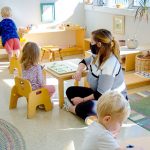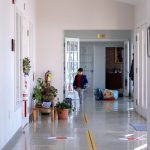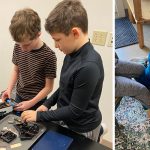The Ubuntu philosophy of many African sub-Saharan countries roughly translates to “I am because we are” or “a person is a person because of other people.” In other words, we owe who we are to others and see ourselves in relation to others. It highlights that our humanity comes from being a member of society and feeling interconnectedness and shared responsibility. Ubuntu resonates with Montessori’s philosophy, which deeply values the need for children to understand themselves in relation to their community.
Fostering Collaboration in the Classroom
“I can help” are words children often say in all our classrooms. When children step up to help one another or work together for a common endeavor, there is a visible growth in their demeanor, confidence, sense of self-worth, purpose, and satisfaction.
Acts of Kindness and Collaboration in Action
A few recent observations around our school have inspired this article.
- A Helping Hand: A 3-year-old was struggling to put on his socks. A 5-year-old who happened to be working nearby stopped her work and, without any prompting, helped the 3-year-old with his socks and returned to work. The younger child was in awe of his senior, who modeled helpfulness without a fuss, and he felt seen by a peer. Compassion happens constantly in our mixed-age classrooms, naturally allowing children with various skill levels and experience to work together.
- Elder Students as Role Models: I am always amazed at the elders in our Primary classrooms, the 5-year-olds, who take great pride in caring for their classroom, moving furniture, setting up lunches, or taking it upon themselves to help younger children with lunch boxes and work. They are like little teachers proactively knowing what needs to get done and doing it with minimal direction. They had observed this work by others before them and naturally became leaders. You can see confidence and purpose in them.
- Collaborative Endeavors in Elementary: In Elementary, children are eager to collaborate, deciding who is doing what and working toward a common goal. Recently, a group of Lower Elementary students were in the hallway holding scripts to Reader’s Theater, coordinating their practice, pitching in ideas, and holding each other accountable. Another group of children in Upper Elementary set out to build a car with a small battery-powered motor. They deliberated and debated over a couple of days, then divided the work based on their skills and interests, successfully sourced the needed materials, built a car, and patted each other’s backs for a job well done. You can see the sense of purpose and accomplishment in these elementary children as they work together for their Holiday Sale and interact with the community, walk the toddlers out to the playground, deliver lunches around the school, read to the reading buddies in Primary, or work through their community service projects.
Guidance and Environment in Education
The intentional design of the environment and curriculum cultivates innate human tendencies. To illustrate, in a traditional model, children are often segregated by age, treated equally in skill level, and provided uniform support. Adults typically direct activities and intervene to maintain order efficiently. While this approach prioritizes individual academic progress, it inadvertently fosters competition and comparison among students.
Research today has proven that cooperative learning has superior outcomes to competitive learning, which focuses solely on an individual’s achievement or goals. Employers seek candidates who are proactive and collaborative workers. This is also what successful entrepreneurs and change-makers are made of.
Children are naturally empathetic and inclined to help and collaborate. It is innately who we are as humans and what we have had to do to survive as long as we have walked the Earth. None of the work I observed was for any incentive or external motivation. When children are given opportunities from a young age, both at home and in school, to participate actively in their communities, organize themselves, and help one another, they grow to become compassionate citizens ready to step up when needed, take on responsibility, and problem-solve together creatively.
The Role of Adults in Cultivating Compassion
While we fundamentally believe in this nature of children, it doesn’t happen in a vacuum. The adult’s role is to guide, model, and create an environment that invites the child to participate actively and uphold the values of one’s responsibility to the community. Montessori intentionally designed various lessons on grace and courtesy for every age group. Our children receive lessons on how to be with each other, how to care for themselves and their environment, and are shown how to practice self-awareness. Then, our teachers step aside and let the children explore the opportunities for themselves while staying observant.
Nurturing Self-Worth and Community
We learn a great deal by observing and doing for each other while also developing social bonds and skills. Most importantly, whether one is on the receiving or giving end of kindness, leading or participating in a team effort, it gives one a sense of self-worth, that “I matter,” “ I can do,” and “I have a role and purpose in this community” and also brings an appreciation for the interdependencies in our societies.










